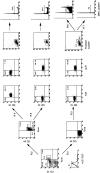Ordering of human bone marrow B lymphocyte precursors by single-cell polymerase chain reaction analyses of the rearrangement status of the immunoglobulin H and L chain gene loci
- PMID: 8976177
- PMCID: PMC2196361
- DOI: 10.1084/jem.184.6.2217
Ordering of human bone marrow B lymphocyte precursors by single-cell polymerase chain reaction analyses of the rearrangement status of the immunoglobulin H and L chain gene loci
Abstract
CD19+CD10+ human B lineage bone marrow cells were separated into cycling or resting cells, which differ in their expression of CD34, VpreB, recombination activating gene (RAG-1), and terminal deoxynucleotidyl transferase (TdT). Polymerase chain reaction analyses developed for DHJH and VkJk, VkJkK(de) and VkK(de) rearrangements with DNA of single cells and a comparison with B lineage cell development in mouse bone marrow, allow to delineate the human B lymphocyte pathway of development as follows: CD34+VpreB+RAG-1+TdT+, DHJH-rearranged, kL germline cycling pre-B I cells-->CD34-VpreB+microH chain+ (pre-B receptor+) RAG-1-TdT-, VHDHJH-rearranged, kL germline, cycling pre-B II cells-->CD34-VpreB-, intracytoplasmic microH chain+ (pre-B receptor-) RAG-1+/-TdT-, VHDHJH-rearranged, mainly kL germline cycling pre-B II cells-->CD34-VpreB-intracytoplasmic microH chain+, RAG-1+TdT-, VHDHJH-rearranged, VkJk-rearranged, IgM-, resting pre-B II cells CD34+VpreB-, sIgM+, RAG-1+TdT-, VHDHJH- and VkJk-rearranged IgM+ immature B cells-->CD34-, CD10-, sIgM+/sIgD+ mature B cells. This order, for the first time established for human B lineage cells, shows striking similarities with that established for mouse B lineage cells in bone marrow.
Figures




References
-
- Osmond DG. Proliferation kinetics and the lifespan of B cells in central and peripheral lymphoid organs. Curr Opin Immunol. 1991;3:179–185. - PubMed
-
- Hardy RR. Variable gene usage, physiology and development of Ly1+ (CD5+) B cells. Curr Opin Immunol. 1992;4:181–185. - PubMed
-
- Rajewsky K. Early and late B-cell development in the mouse. Curr Opin Immunol. 1992;4:171–176. - PubMed
-
- Tsubata T, Nishikawa S. Molecular and cellular aspects of early B-cell development. Curr Opin Immunol. 1991;3:186–192. - PubMed
-
- Rolink A, Melchers F. Generation and regeneration of cells of the B-lymphocyte lineage. Curr Opin Immunol. 1993;5:207–217. - PubMed
Publication types
MeSH terms
Substances
LinkOut - more resources
Full Text Sources
Other Literature Sources
Medical

